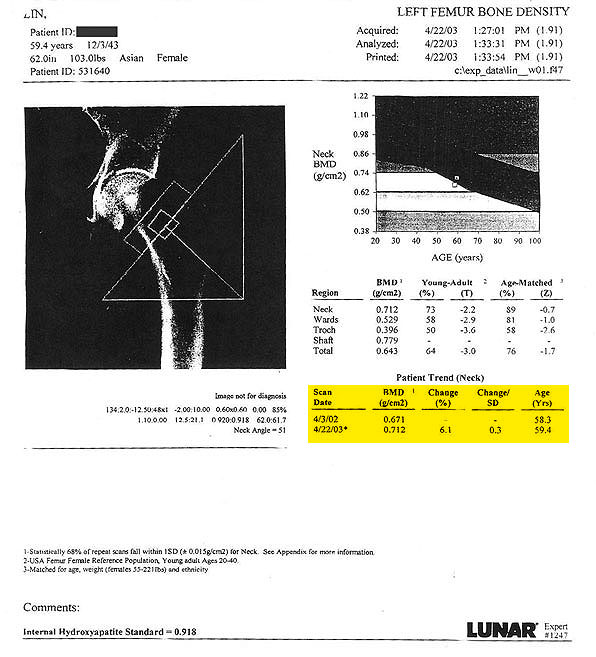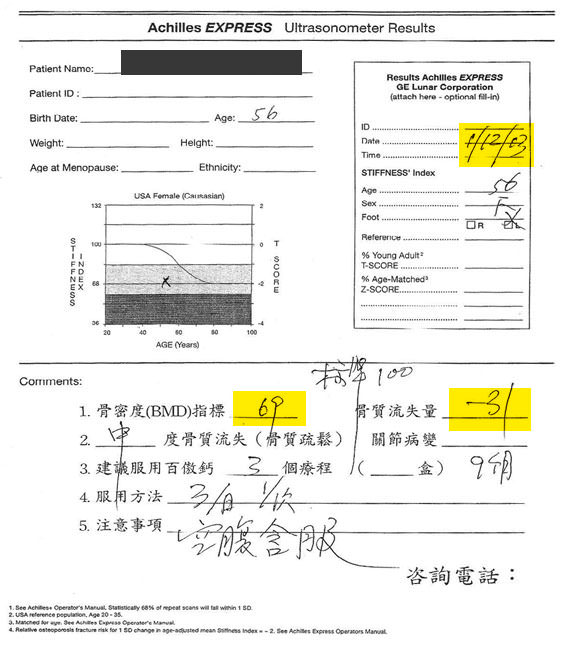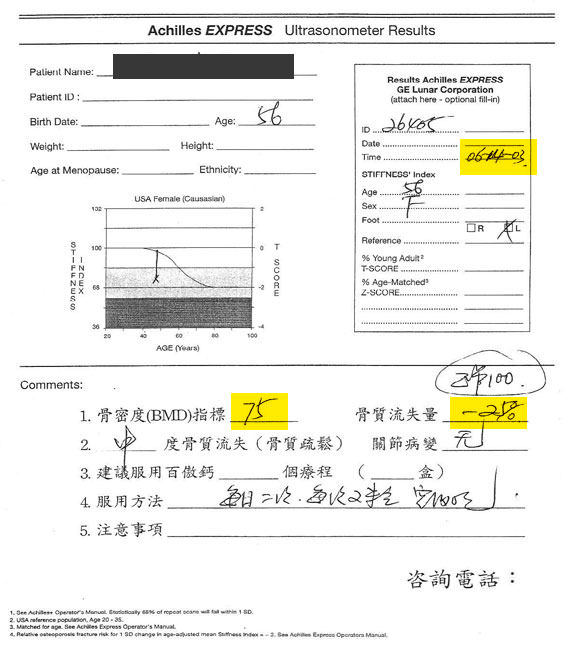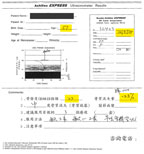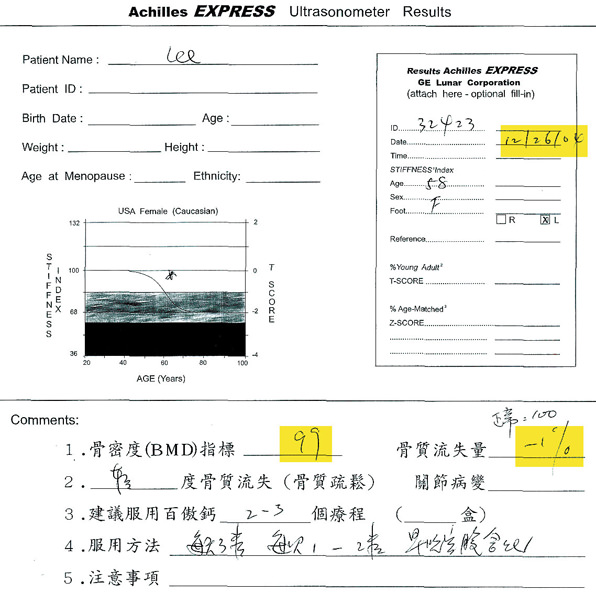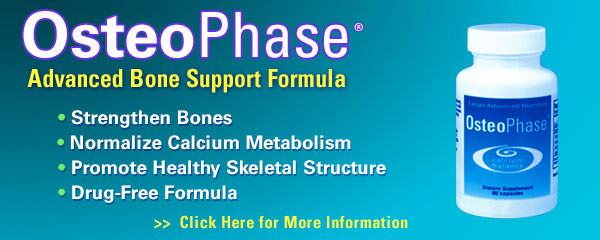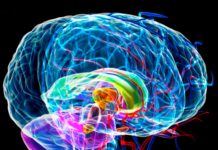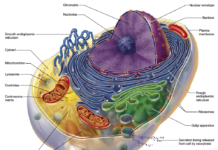An advanced Chinese herbal formula – OsteoPhase® – has been shown to safely aid in rebuilding skeletal bone and resolving calcium overload. Preliminary clinical findings indicate that the formula regulates calcium to benefit conditions such as osteoporosis, hyperglycemia and other calcium-related disorders. In safety evaluation trials the formula was found to dramatically restore bone mass density – in some cases to levels consistent with those of a healthy 30-year old female.
Clinical Benefits of Chinese Herbs for Osteoporosis
OsteoPhase has been shown to significantly reverse bone loss and enhance bone density, as determined by bone mineral density (BMD) measurements by DEXA (dual-energy x-ray absorptiometry) and Achilles (ultrasonometer) scans.
In the first case, a 58-year-old female enrolled in a safety evaluation trial of OP after a DEXA scan revealed osteopenia in her hip. The subject took the formula daily for a four-month trial period. Eight months later, a full year after starting the trial, a second bone scan revealed that the subject’s bone mass density score had increased a significant 6% (Fig. 1).
Fig. 1. Improvement in bone density (6.1%) of woman (age 59 years) taking OsteoPhase for
only 4 months after her first DEXA scan revealed osteopenia.
In the second case, a 56-year-old female experienced even greater benefit. After an Achilles scan established a baseline BMD score of 69 (Fig. 2-a), the subject received the formula for four months. The subject was measured a second time at 6 months – only 2 months after last taking OsteoPhase. The second scan (Fig. 2-b) again showed a significant benefit, with a new BMD of 75, indicating a 10% (7 point) improvement in bone density.
Fourteen months later, a third bone test was conducted to determine possible residual effects of OsteoPhase. Remarkably, the new test revealed that the subject’s BMD had further increased to 77, (Fig. 2-c) indicating a long-term restorative benefit on calcium metabolism – in this case, a full 16 months after the last dose!
Impressed with her results, the subject volunteered for a second, shorter trial. Lasting almost 2 months, the new study was designed to evaluate the efficacy of OsteoPhase in combination with two other formulas. The first consisted of a unique blend of minerals, including zeolyte. The second was an herbal blend designed to enhance blood health and improve circulation (FemmePhase).
The results of the combination therapy resulted in a fourth bone density scan score of 99 (Fig. 2-d), indicating bone density comparable to a healthy 30 year old female. To confirm the validity of the test results, a second scan was ordered, resulting in a BMD of 100. This was well within the testing margin of error and confirmed the earlier score.
Osteoporosis
Osteoporosis is a systemic skeletal disease characterized by low bone mass and accelerated deterioration of bone tissue. Osteoporosis affects an estimated 28 million Americans, and an additional 34 million with low bone mass (osteopenia) are at increased risk of developing the condition.
Osteoporosis causes more than 1.5 million serious fractures annually, and it is estimated that 50 percent of all women and 25 percent of all men over 50 will experience an osteoporosis-related fracture in their lifetime.
Osteoporosis-related fractures commonly occur in the hips, spine, and wrist. Hip fractures are the most serious, as approximately 25 percent of patients over 50 years of age die within one year of suffering a fracture. Of those who do recover from a hip fracture, only 15% regain enough mobility to walk across a room unaided within one year.
Current treatment for osteoporosis includes the use of hormones and bisphosphonate drugs. Hormone therapy presents serious side effects with long-term use, and the high cost of bisphosphonate precludes their use in the general population.
Bone Physiology
Throughout life bone tissues are continually renewed in a process called bone remodeling. Bone remodeling is effected by two types of specialized bone cells – osteoclasts and osteoblasts.
Osteoclasts dissolve old bone in a process called bone resorption. Osteoblasts then deposit collagen, which is then mineralized with calcium hydroxyapatite crystals to complete the formation of new bone.
Healthy bone mass depends on maintaining the balance between the resorption and formation phases of bone remodeling. When this balance is disrupted the result is the loss of bone mass and increased bone fragility.
Restoring Calcium Balance
OsteoPhase is a marine-based nutritional product developed during ten years of clinical research to identify and isolate a number of biologically active proteins and enzymes derived from the inner lining of oyster shells. These tissues are primarily responsible for stimulating and controlling the formation of new shell growth from available marine calcium.
The researchers developed a proprietary process for extracting these bioactive ingredients which are then blended with ionic calcium and medicinal herbs that have previously been shown to enhance healthy calcium regulation. The result is a unique formula that safely reduces bone loss, increases bone density, and increases bone remodeling.
How OsteoPhase Works
Initial research on OsteoPhase indicates that the formula aids in regulating calcium balance (homeostasis) by increasing bone density and normalizing (reducing) calcium levels in the blood and cells. These physiological effects are well supported by independent studies of the herbal ingredients contained in the formula.
Concha Ostrea
Concha Ostrea oyster shell provides calcium carbonate, along with additional minerals, glycolipids and nutrients. Ostrea is commonly used in traditional Chinese medicine for heart palpitations, anxiety, restlessness, insomnia and inflammation.
Astragalus Polysaccharides
Extracts of Astragalus have been shown to inhibit bone loss in post-menopausal women.
Angelica Sinensis
Angelica has been shown to stimulate the proliferation of precursor cells that develop into osteoblasts and osteoclasts.
Coix Seed
Coix seeds lower blood sugar and counteract inflammation and fibrosis formation.
Effects of Formula on Glucocorticoid-Induced Osteoporosis
Steroid (glucocorticoid) drugs, such as prednisone, are well known to contribute to osteoporosis. Steroids speed up the rate at which bone is dissolved, and simultaneously slow the growth of new bone tissue, resulting in rapid and devastating bone loss. An average of 5% of bone mass is lost in the first year of steroid use. Consequently, fracture rates among patients on long-term steroid therapy range from 30-50%.
Preliminary studies in China have found that OsteoPhase has a preventive effect against glucocorticoid-induced osteoporosis. The formula was shown to reduce calcium losses by 69%, while increasing bone density by 27% and enhancing bone remodeling by 100%.
Alleviating Symptoms of Avascular Necrosis of the Hip
Additionally, the herbs contained OsteoPhase are widely used in Chinese hospitals to treat Avascular Necrosis, a severe disorder related to osteoporosis. Avascular Necrosis disrupts circulation to the head of the femur, causing tissue death and the eventual collapse of the bone structure.
Researchers in Beijing treated 1,286 Avascular Necrosis patients, of which chronic steroid use was a predisposing factor for 669 (52%) of the patients. In clinical reports of treatment of the disorder with the herbs contained in OsteoPhase, 90% of patients showed improvement in alleviating symptoms of pain and stiffness, and partial reversal of bone deterioration was observed by x-ray.
Osteoporosis Not and Isolated Disorder
In addition to supporting bone formation, calcium is required for cellular metabolism and regulation of physiological functions. Consequently, as calcium is released from bone it spills over into the body, elevating calcium levels in blood and soft tissues. This overload can cause arteries to calcify while muscle, nerve, and other cells lose function. Calcium imbalance (dysregulation) also affects secretion of endocrine hormones such as insulin, and is an underlying cause of disorders ranging from diabetes to cardiovascular disease.
The problem of calcium imbalance cannot be solved by simply increasing one’s intake of calcium – an approach analogous to pouring water into a leaky container that drains out as fast as it’s filled. A more rational and effective approach is to restore the body’s natural mechanisms for regulating and maintaining healthy calcium levels.
Who Should Take OsteoPhase?
Many conditions are associated with elevated risk for osteoporosis and the subsequent increase of fractures in men and women. Those most at risk include:
- Women 65 and older
- Post-menopausal women experiencing fractures
- Estrogen deficient women
- Individuals with vertebral abnormalities
- Individuals on glucocorticoid (steroid) therapy
- Individuals with primary hyperparathyroidism
Safety and Use
OsteoPhase is safe for daily use. The herbs in the formula are commonly used in health formulations throughout Asia, the US and Europe to aid in maintaining optimal health. Additional benefits of regular use include improved immune system function, enhanced cell regulation, and improved overall health for both men and women.
Technical Review and References
Osteoporosis and Calcum Dysregulation
Osteoporosis, or porous bone, is a skeletal disease characterized by low bone mass and deterioration of the structure of bone tissue. Osteoporosis is marked by bone fragility and increased risk of fractures, especially of the hip, spine, and wrist.
Osteoporosis is not, however, an isolated disorder. The calcium lost from bone tissue floods and overloads body fluids and tissues. Because of the central role of calcium in all cell metabolism, this overload of calcium contributes to a multitude of other disorders. Researchers find that when calcium is deficient in skeletal bone, it is elevated in the blood and within tissue cells. While our bones become fragile and brittle, our arteries calcify, and our endocrine secretions, including insulin are disrupted. At the same time our muscle, nerve, and other cells lose function as they become overloaded with calcium.
The underlying mechanism that connects these disorders is loss of calcium ion homeostasis, or dysregulation of calcium ion flow. The problem of faulty calcium homeostasis is not solved by calcium supplementation, but by restoring proper regulation of calcium ion flow.
Clinical evaluation in China of OP was based on a regulating dose of the formulation that contained less than 125 mg. per day of calcium. This level of calcium intake is far below the 1000 to 1500 mg. of daily calcium supplementation recommended by nutritionists and physicians in the US and elsewhere to protect against bone loss. This fact also supports the hypothesis that the formula achieves its results by calcium regulation and not by supplementation.
OP is a marine-based nutritional product developed through ten years of research. The formula is a unique supplement made from Concha ostrea (Ostrea talienwhanensis – an oyster shell), Astragalus polysaccharides, Angelica sinensis root, and Coix seeds. All are common ingredients used for nutritional and therapeutic purposes in modern Chinese medicine. OP is manufactured by a patented, high-tech process and contains ionic calcium (Ca2+), astragalus polysaccharides, 21 different amino acids, iron, zinc, and other biologically active molecules.
The ability of OP to regulate calcium ion homeostasis is attributed to its unique ratio of ingredients and to a special manufacturing process developed at a marine medicine institute. The lead researcher at the institute identified biologically active proteins and enzymes from the inner lining of the oyster shell that are responsible for stimulating the formation of the shell from available calcium. He then developed a proprietary process for extracting these bioactive ingredients along with ionic calcium from the shell and combined them with three medicinal herbs that contribute to calcium regulation. The result of his work is the OP formula, now available to men and women in the US that suffer from osteoporosis and the damage caused by the flooding of cells and soft tissues of calcium leached from bone tissue by various causes.
Osteoporosis Morbidity
Osteoporosis is a major public health problem in the US and worldwide. An estimated 10 million Americans already have the disease with another 34 million having low bone mass, or osteopenia, putting them at increased risk for osteoporosis and fracture.
One in two women, and one in four men over age 50 will have a fracture related to low bone mass in his or her remaining lifetime. More than 1.5 million fractures are attributed to osteoporosis annually, including:
- 300,000 plus hip fractures
- 700,000 vertebral fractures
- 250,000 wrist fractures
- 300,000 fractures at other sites
The estimated costs associated with these fractures nationally for medical care in hospitals and nursing homes was $17 billion in 2001.
Hip fractures are the most problematic of the various fractures. An average of almost 25% of hip fracture patients over age 50 die in the year following their fracture. While the rate of hip fractures in women is two to three times higher than in men, the one year mortality rate is nearly twice as high for men.
At six months after a hip fracture, only about 15% of patients can walk across a room unaided.
Bone Physiology
In order to understand the causes and effects of osteoporosis, it is important to know that bone is living tissue. Structurally, our bones serve as a scaffold for the musculoskeletal system and protect internal organs. Just as importantly, bone tissue is an important metabolic reservoir, centrally involved in hemopoeisis, or blood formation, and in calcium homeostasis.
After we reach adulthood our bones no longer continue to grow in length. However, just like all other tissues of the body, bones do continue to renew themselves in a process called bone remodeling. Old bone is constantly being replaced by new bone. New bone is stronger than old bone, so bone remodeling is important in maintaining bone strength. It is also crucial to maintain the ongoing contribution of bone tissue to calcium regulation and blood formation.
Bone remodeling is controlled by two types of bone cells – osteoclasts and osteoblasts. Osteoclasts and osteoblasts work together to form new bone.
Osteoclasts secrete an acid like substance that dissolves bone mineral and digests bone matrix leaving small cavities or pits in bone tissue. This process is called bone resorption.Osteoblasts then refill the cavity with new bone, called osteoid. The osteoblasts first synthesize bone matrix, 90% of which is made up of type I collagen. In the next stage the osteoid matrix is mineralized with calcium hydroxyapatite crystals, completing the formation of new bone.
Osteoporosis Pathology
The matrix of all bones consists of two types of microstructure – trabecular bone tissue or cortical bone tissue. The spine and vertebrae are mainly trabecular bone. The ends of the long bones of the body are 75% trabecular and 25% cortical. The rest of the long bones are cortical. Bone remodeling, or replacement of weak, old bone with new, strong bone is more active in trabecular bone where 40% of all bone tissue is recycled each year. In cortical bone, only 10% is remodeled each year.
Healthy bone mass is maintained when the resorption and formation phases of bone remodeling are balanced when osteoclasts and osteoblasts work together as a unit. Bone loss occurs when the functions of osteoclasts and osteoblasts are uncoupled.
When bone remodeling becomes faulty, as in osteoporosis, it does most of its damage in trabecular bone tissue, which is why most osteoporotic fractures occur at the following locations:
- Vertebrae of the spine
- Neck of the femoral bone at the hip
- Ends of long bones, in particular the radius of the wrist
Primary, or involutional, post-menopausal bone loss accounts for 80% of all osteoporotic fractures. Involutional bone loss takes two forms – in Type I, osteoclast activity is excessive and in Type II, osteoblast activity is hindered.
- Type I. Accelerated bone loss in recently menopausal women is associated with overactive osteoclasts and is closely related to loss of ovarian function. Excessive osteoclast activity creates resorptive cavities that are too deep for osteoblasts to fill with new osteoid matrix. This type of bone loss occurs mainly in trabecular bone tissue. Women lose 5-10% of their bone mass in the first five years after their last menstrual period. More than 40% of all women aged 50-75 will experience low energy osteoporotic fractures. The tendency is for them to experience vertebral fractures from age 55 to 70 and femoral fractures over age 70.
- Type II. Slower, age-dependent bone loss results from osteoblast underactivity. After the accelerated bone mass loss in the five years after menopause, women lose about 1% of their bone mass per year. In Type II involutional osteoporosis osteoblasts cannot adequately fill normal resorptive cavities with new osteoid matrix. This bone loss concentrates in the cortical bone tissue that is the primary tissue of skeletal long bones.
Secondary osteoporosis accompanies many medical conditions, including hyperthyroidism, hyperparathyroidism, diabetes, adrenocortical overactivity, rheumatoid arthritis, and chronic use of various medications, particularly corticosteroids. Secondary osteoporosis is also a consequence of chronic alcohol abuse and smoking addiction.
The best way to determine risk is to have a bone mass density test. Several types of devices measure loss in bone mass density and indicate development of osteoporosis with a high degree of accuracy. These devices give scores that indicate bone loss compared to normal healthy subjects. The following chart gives the definitions of degrees of bone loss and recommended levels of intake of OsteoPhase.
Normal
Bone density score of +1 SD to –1 SD of young adult mean [SD is Standard Deviations]
1 capsule daily as preventative
Low Bone Mass or Osteopenia
Bone density score of –1 to –2.5 SD [Density is 1-2.5 Standard Deviations below the young adult mean]
3 capsules daily as restorative
Osteoporosis
Bone density score of >-2.5 SD [Density is 2.5 Standard Deviations or more below the young adult mean]
6 capsules daily as restorative
Severe [established] Osteoporosis
Bone density score of >-2.5 SD, and one or more osteoporotic fractures
6-9 capsules daily as restorative
It is recommended that a follow-up bone mass density test take place after three months use of OsteoPhase. Daily use can then be adjusted based on the results of the test.
Calcium Regulation and Homeostasis
A large part of physiology is concerned with regulatory mechanisms that act to maintain healthy internal function. Calcium ions are the most important molecules that serve as regulatory signals. After acting to initiate various physiological functions, from nerve and muscle cell firing to release of hormones into the blood stream, calcium is restored to its set points in various cells and tissues by different homeostatic feedback loops. There is a constant shifting of calcium from its various storage locations in bone, blood, tissue fluids, and cells. When this shifting goes awry, calcium dysregulation occurs and many tissues lose optimal function.
Calcium dysregulation becomes an underlying cause of many disorders, from cardiovascular disease to diabetes. While our bones become fragile, our soft tissues become inflamed and calcified. The impact of OP on cardiovascular disease is based on its ability to antagonize elevated levels of calcium in the blood and interrupt calcification, plaquing and fibrosis in arterial tissues. In diabetes, calcium overload disrupts the interplay between glucose levels and calcium ions in the release of insulin.
Research scientists are analyzing the central role of calcium dysregulation in Alzheimer’s disease, nerve cell damage, kidney nephrosis, bi-polar disorder, muscular dystrophies, periodontal disease, non-healing of fractures, tumor cell proliferation.
Initial research on OsteoPhase indicates that it regulates calcium homeostasis by increasing bone density and by antagonizing high calcium levels in the blood and cells. While this positive aspect of the formula is awaiting further verification through clinical evaluation, the initial results are very promising. The formula itself is very safe for daily use as all of the herbs are common medicinals in wide use in health formulations throughout Asia, the US and Europe. The four ingredients in OsteoPhase are key ‘Essence’ herbs thought to play beneficial roles in maintaining optimal health as we age. The “side effects” of regular use in preventing and restoring bone loss will be improved immune system function, better cell regulation, and enhanced overall health for both men and women.
OP Ingredients
The physiological effects of OsteoPhase on bone tissue are supported by independent studies of the four ingredients that compose the formula as indicated below.
Concha Ostrea (Ostrea talienwhanensis, Oyster shell)
Concha Ostrea contains calcium carbonate [80-85%], calcium phosphate, calcium sulfate, magnesium, ferric oxide, silicon dioxide, glycogen, betain, taurine, glutathione, keratin, oburidine, adenine, venerupin, glycolipid, lysine, tyrosine, methionine, leucine, arginine, histidine, threonine, valine, succinic acid, sterol, fats, vitamins A, B1, B2, D.
Oyster shell is commonly used in traditional Chinese medicine for heart palpitations accompanied by anxiety, restlessness and insomnia. Additionally, oyster shell is used in reducing various types of swellings. Research in Japan and China indicates that both hydrolysed and electrolysed oyster shell increases calcium absorption and improves bone density.
Astragalus Polysaccharides (Radix Astragali, Astragalus membranaceus)
Polysaccharides from Radix Astragali (Astragalus) are well studied as potent immune modulators and are particularly valuable in restoring depressed immunity. They have been shown to partially reverse the effect of prednisolone in mice, which may account for its contribution to countering the effects of chronic corticosteroid use on rates of osteoporosis formation.
In post-menopausal women, osteoclast activity increases over osteoblasts activity due to decline in estrogen production. This uncoupling or imbalance in breakdown of old bone and stimulation of new bone formation leads to the dramatic losses of bone mass in women after their last menstrual period at the beginning of menopause.
Ovariectomy, the surgical removal of the ovaries, induces bone loss and is used to study the effects of a decrease in estrogen on bone tissue. Extracts of Astragalus inhibit bone loss in ovariectomized rats. This herb alone will likely contribute to the prevention of bone loss in post-menopausal women who were counting on hormone replacement therapy for this purpose.
Angelica Sinensis
Angelica sinensis is an herbal medicine known for its effect to purify blood quality and improve circulation. It frequently appears as the main ingredient in herbal prescriptions for bone injuries. An aqueous extract of Angelica sinensis was found to directly stimulate the proliferation, alkaline phosphatase (ALP) activity, protein secretion and particularly type I collagen synthesis of OPC-1 in a dose-dependent manner. OPC-1 are bone marrow osteoprecursor cells that differentiate into osteoblasts and osteoclasts in the process of osteogenesis or bone formation.
Osteoblasts secrete large quantities of ALP when they are actively forming/depositing bone matrix. ALP is believed either to increase the local concentration of inorganic phosphate or to activate the collagen fibers in such a way that they cause deposition of calcium salts into the bone matrix (osteoid). Since some ALP diffuses into the blood during this process, the blood level of ALP is usually a good indication of bone formation and is one of the marker tests to evaluate osteoporosis.
Coix
Coix seeds are included in the formulation for their ability to lower blood sugar and counteract inflammation and fibrosis formation.
References
1. Osteoporosis: Prevention, Diagnosis and Management, 3rd Edition, Morris Notelovitz, MD, PhD, Professional Communications, Inc., 1999.
2. Treatment of Avascular Necrosis of the Femoral Head with Chinese Herbs, by Subhuti Dharmananda, PhD, Director, Institute for Traditional Medicine, Portland, Oregon, www.itmonline.org published December, 2003.
3. Guytons Physiology Text
4. www.nof.com – National Osteoporosis Foundation website.
Pub Med Citations
5. Shen X, Lu R, Wu M. [Metabolism and utilization of calcium derived from hydrolysed oyster shell in rats] Zhonghua Yu Fang Yi Xue Za Zhi. 1996 Mar;30(2):91-3
6. Fujita T, Fukase M, Miyamoto H, Matsumoto T, Ohue T., Increase of bone mineral density by calcium supplement with oyster shell electrolysate. Bone Miner. 1990 Oct;11(1):85-91.
7. Fujita T, Fukase M, Nakada M, Koishi M., Intestinal absorption of oyster shell electrolysate. Bone Miner. 1988 Sep;4(4):321-7.
8. Wang H, Li J, Yu L, Zhao Y, Ding W, Antifibrotic effect of the Chinese herbs, Astragalus mongholicus and Angelica sinensis, in a rat model of chronic puromycin aminonucleoside nephrosis. Life Sci. 2004 Feb 13;74(13):1645-58
9. Kim C, Ha H, Lee JH, Kim JS, Song K, Park SW., Herbal extract prevents bone loss in ovariectomized rats. Arch Pharm Res. 2003 Nov;26(11):917-24
10. Yang Q, Populo SM, Zhang J, Yang G, Kodama H. Effect of Angelica sinensis on the proliferation of human bone cells. Clin Chim Acta. 2002 Oct;324(1-2):89-97.
11. Kim SO, Yun SJ, Jung B, Lee EH, Hahm DH, Shim I, Lee HJ. Hypolipidemic effects of crude extract of adlay seed (Coix lachrymajobi var. mayuen) in obesity rat fed high fat diet: relations of TNF-alpha and leptin mRNA expressions and serum lipid levels. Life Sci. 2004 Jul 30;75(11):1391-404.
12. Hung WC, Chang HC. Methanolic extract of adlay seed suppresses COX-2 expression of human lung cancer cells via inhibition of gene transcription. J Agric Food Chem. 2003 Dec 3;51(25):7333-7.
13. Hsu HY, Lin BF, Lin JY, Kuo CC, Chiang W. Suppression of allergic reactions by dehulled adlay in association with the balance of TH1/TH2 cell responses. J Agric Food Chem. 2003 Jun 18;51(13):3763-9.
14. Seo WG, Pae HO, Chai KY, Yun YG, Kwon TH, Chung HT. Inhibitory effects of methanol extract of seeds of Job’s Tears (Coix lachryma-jobi L. var. ma-yuen) on nitric oxide and superoxide production in RAW 264.7 macrophages. Immunopharmacol Immunotoxicol. 2000 Aug;22(3):545-54.
15. Check JB, K’Ombut FO. The effect on fibrinolytic system of blood plasma of Wister rats after feeding them with Coix mixed diet. East Afr Med J. 1995 Jan;72(1):51-5.
16. Roman Ramos R, Alarcon-Aguilar F, Lara-Lemus A, Flores-Saenz JL. Hypoglycemic effect of plants used in Mexico as antidiabetics. Arch Med Res. 1992 Spring;23(1):59-64.
17. Takahashi M, Konno C, Hikino H. Isolation and hypoglycemic activity of coixans A, B and C, glycans of Coix lachryma-jobi var. ma-yuen seeds. Planta Med. 1986 Feb;(1):64-5
18. Gomita Y, Ichimaru Y, Moriyama M, Fukamachi K, Uchikado A, Araki Y, Fukuda T, Koyama T. [Behavioral and EEG effects of coixol (6-methoxybenzoxazolone), one of the components in Coix Lachryma-Jobi L. var. ma-yuen Stapf] Nippon Yakurigaku Zasshi. 1981 Mar;77(3):245-59.











